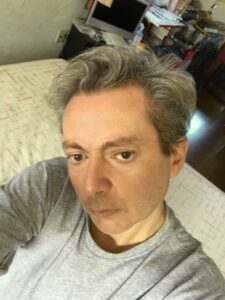Zazen means “sitting.” Shikantaza means “just sitting.” In Shikantaza one does not pay focused attention towards breathing, or silent chanting, or any other mental device. One’s only goal—if it can be called a goal (not really!) —is absorption of self.
By YB Roth
My name is Youngbear Roth, and my friends call me YB; Please, do.
I started practicing basic Hatha Yoga when I was nine-years-old. Until that time I wore steel and leather braces from the waist down, and in square-toed shoes I waddled like a duck. Thanks to a forward thinking doctor—this was in the1950s—my mother learned about a yoga master, Richard Hittleman, who was using his television show to teach an exercise from the mysterious East called yoga. My mother and I practiced our yoga daily and my doctor approved dropping the braces. I had no idea at that time that playing to cure my physical condition in front of the television with my mother would years later be reintroduced in my life as a serious compensatory learning tool, and additionally as a spiritual and philosophical key to open doors of inquiry initiated by me as a young man in my teens and early twenties.
By that time my yoga survived the interruptions of growing up in the 1960s and 1970s, and always reappeared, my path deepening each time. When I married in 1974, I was searching for answers; at that time specifically to a question plaguing me since I stopped formal schooling at age 13—”Why,” I pleaded with myself, “can’t you learn?”
I had myself tested…again. I had been tested throughout my childhood. All my parents and I could learn was that I struggled with a learning disability. What to call this unfathomable anvil, which I now call my gift, and how to resolve the issue, no one knew. Suggestions from experts flowed in, but no concrete answers. When I met the expert who would test me this time, I was bitter; my anvil had caused me untold misery on educational, social, familial, and self-esteem levels for almost 30 years. After a weighty battery of tests over three weekends, this time my expert held in her hand a thick sheaf of documents. For the first time I was offered concrete answers.
I learned that I functioned under the umbrella of autism, and later I further discovered my autism presented itself as Aspergers. I was crippled, she said, with a severe short-term memory deficit and also slow processing. While my intelligence is quite high—I read well per word—due to my memory and processing time, I cannot string the words together to form a meaningful sentence.
Aspergers was no longer my anvil. Aspergers became my home base; a gift from where I could experiment with a direction and find resolution to my learning disability. I was thrilled knowing I was autistic because by better understanding my disabilities, I simultaneously better understood by abilities. I began thinking creatively about how to most effectively use my options. I chose yoga as my living program’s foundation.
I realized that meditation would most naturally be my closest ally, because I grew up without ready-made expert answers to my challenges, and without many friends that could bear my moods, callus outbursts, and lack of social graces. I had only myself. I developed strongly exercised in focused intellectual and emotional self-examination. At the time of this gift discovery along my path, I had begun experimenting using various styles of yoga meditation. Now, after understanding my most effective options, I selected a serious practice of the Japanese yoga mediation style called Zazen, and a specific Zazen style known as Shikantaza. Zazen means “sitting.” Shikantaza means “just sitting.” In Shikantaza one does not pay focused attention towards breathing, or silent chanting, or any other mental device. One’s only goal—if it can be called a goal (not really!) —is absorption of self. The process takes one very naturally through many questions and possible answers because we are human and we do think, consider, and question.
Eventually, after exhausting the questions and answers, all that is left is just sitting with an awareness of this moment’s self.
How did just sitting in yoga meditation aid my autistic nature and my Aspergers moodiness and lack of social abilities, and additionally, my learning disabilities? I learned acceptance of my mental and emotional process; I learned how to step out of my own way and just “be” long enough not to be frustrated by my memory deficit, which meditation practice eradicated much of my frustration and helped me coast between words with less loss of memory—not perfect, but a huge improvement—along with learning to read more smoothly, I learned how to follow conversations; I developed the confidence to join in conversations, and I discovered that a great deal of the time I actually liked people; finally, I evolved from an acceptance of myself, and learning I had the capacity to like others, to feeling good about myself.
At long last, feeling good about myself, my world opened up. Sharing with you today is a genuine pleasure. I hope that you will send your questions and comments to litarts@pacbell.net. Share with me so that I may use your questions and commentary to write further blogs in this space.
Namaste’ is a yoga greeting. A cultural buzzword meaning “I respect your energetic process and my energetic process as one.”
Namaste’ my friends,
YB
Youngbear Roth, RYT, CYT is a semi-retired practicing Integral Yoga therapist, East-West journalist, and academic research scientist in mental health since 1972. His work appears in over 400 international journals and magazines. Youngbear has lived with his wife for 40 years in Los Angeles, California.










Thank you, Young Bear. Your words are genuine, resonate truth, and bring comfort to me.